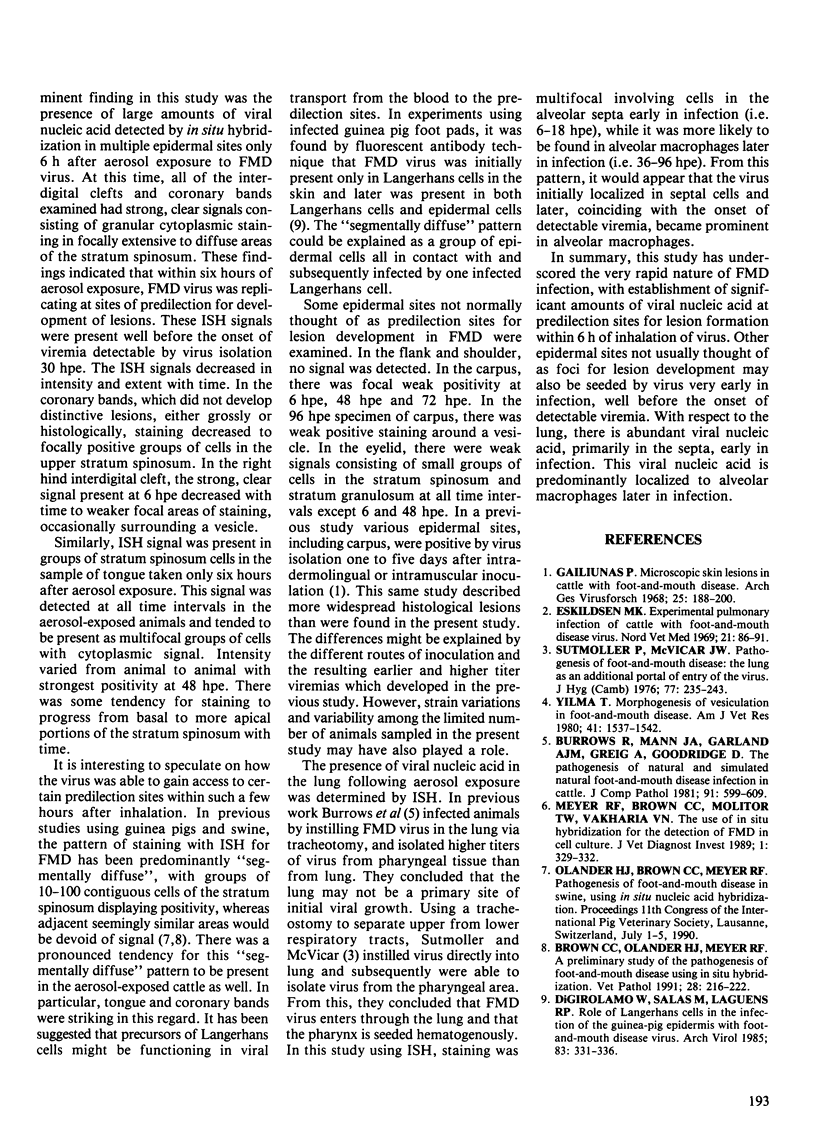Abstract
Eight calves were exposed in an aerosol chamber to nebulized foot-and-mouth disease virus. Two control animals were exposed in a similar manner to cell culture media only. Animals were euthanized at intervals and various tissues examined by in situ hybridization using a biotinylated RNA probe corresponding to a portion of the viral gene coding for the polymerase enzyme. By this technique large amounts of viral nucleic acid were found in coronary band, interdigital cleft and tongue as early as six hours postexposure, indicating a very rapid delivery from the portal of entry to the predilection sites for lesion development. This occurred well before the onset of viremia which by virus isolation was not detectable until 30 hours postexposure. The in situ hybridization signal in these tissues decreased in intensity and extent with time to focally positive areas, occasionally surrounding a vesicle. Other epidermal sites not normally thought of as sites for foot-and-mouth lesion development, such as carpus and eyelid, also had some viral nucleic acid detectable at various time intervals. In the lung by in situ hybridization, alveolar septa had viral nucleic acid early in infection (6-18 h postexposure) while later (36-96 h postexposure), the in situ hybridization signal was prominent in alveolar macrophages.
Full text
PDF




Images in this article
Selected References
These references are in PubMed. This may not be the complete list of references from this article.
- Brown C. C., Olander H. J., Meyer R. F. A preliminary study of the pathogenesis of foot-and-mouth disease virus using in situ hybridization. Vet Pathol. 1991 May;28(3):216–222. doi: 10.1177/030098589102800305. [DOI] [PubMed] [Google Scholar]
- Burrows R., Mann J. A., Garland A. J., Greig A., Goodridge D. The pathogenesis of natural and simulated natural foot-and-mouth disease infection in cattle. J Comp Pathol. 1981 Oct;91(4):599–609. doi: 10.1016/0021-9975(81)90089-x. [DOI] [PubMed] [Google Scholar]
- Gailiunas P. Microscopic skin lesions in cattle with foot-and-mouth disease. Arch Gesamte Virusforsch. 1968;25(2):188–200. doi: 10.1007/BF01258164. [DOI] [PubMed] [Google Scholar]
- Meyer R. F., Brown C. C., Molitor T. W., Vakharia V. N. Use of in situ hybridization for the detection of foot-and-mouth disease virus in cell culture. J Vet Diagn Invest. 1989 Oct;1(4):329–332. doi: 10.1177/104063878900100409. [DOI] [PubMed] [Google Scholar]
- Sutmoller P., McVicar J. W. Pathogenesis of foot-and-mouth disease: the lung as an additional portal of entry of the virus. J Hyg (Lond) 1976 Oct;77(2):235–243. doi: 10.1017/s0022172400024669. [DOI] [PMC free article] [PubMed] [Google Scholar]
- Yilma T. Morphogenesis of vesiculation in foot-and-mouth disease. Am J Vet Res. 1980 Sep;41(9):1537–1542. [PubMed] [Google Scholar]
- di Girolamo W., Salas M., Laguens R. P. Role of Langerhans cells in the infection of the guinea-pig epidermis with foot-and-mouth disease virus. Arch Virol. 1985;83(3-4):331–336. doi: 10.1007/BF01309929. [DOI] [PubMed] [Google Scholar]




